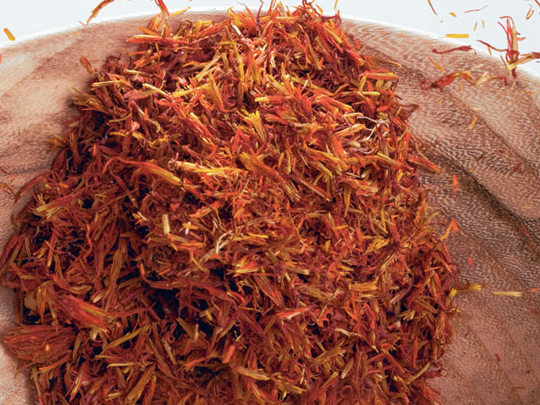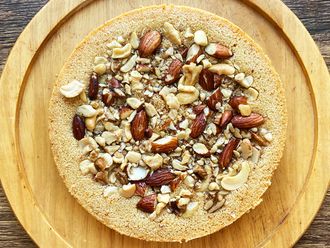
How would you describe the taste of saffron?
It's sweet but bitter. It smells of hay, the ocean, diesel, bonfire embers and well-rotted apples. Its aroma is gentle but overpowering, as delicate as a surgeon and as sharp as a blow.
Although people use turmeric to approximate its colour, it has no substitute flavour, no lemon-to-lime or cod-to-pollock neighbour. It dominates the dishes it appears in but acts as a mere backnote to other ingredients. Nothing in the kitchen is as full of paradox and subtlety as this beautiful yet expensive spice.
It's the stigma of a pretty crocus native to a strip of western Asia. The modern plant is sterile, the hard-won result of cross-breeding and human-led Darwinism. Every year, people have to dig it up, split the bulb-like corms that form part of its root and replant them. The flowers bloom in October, pushing out two or three fragile, wispy stigmas that you can only harvest by hand and pickers work through the night to catch these at their coy, alluring best.
Expensive and precious
It's punishing, fiddly work. So saffron is notoriously the most expensive spice, its retail price often exceeding that of gold. Harrods, who know about this sort of thing, were kind enough to give me two grams of the finest: a bit of Spanish and some Moroccan. Together, the tiny jars used around 400 flowers and cost more than £25 (Dh140).
For as long as there have been people, people have known about saffron. A dye from its stigmas colours 50,000-year-old cave paintings in what is now Iraq.
Ancient frescoes on the Greek island of Santorini depict a female deity watching or perhaps blessing a woman picking saffron, presumably for medicine. No one knows how old this painting is: A volcano buried it around 1,500BC and the work could have been hundreds of years old even then. Ovid wrote that Smilax changed her pursuer Crocos into a flower, leaving the red stigma as a symbol of his passion.
Another myth describes Hermes, the messenger to the deities, accidentally wounding his friend Crocos: Blood dripping from Crocos's head fell on the ground, where Hermes changed it into the flower. Zeus slept on a bed of saffron. The spice appears in Chinese writings dating to 1,600BC.
The fall
The Romans grew saffron in Gaul but when the empire fell, so did the civilised taste for the spice. The Moors reintroduced saffron to a benighted continent in the 8th and 9th centuries. When the Black Death scourged Europe, the mountebanks peddling their snake oils caused something of a Delia Effect on saffron, which often featured in the desperate nostrums of the day and the price rose accordingly.
Basel, of all places, was the centre of the European saffron industry in the Middle Ages and unscrupulous dealers would, under local law, be burnt alive for selling an adulterated product. Then, as now, cheap imitations based on turmeric and safflower tempted the chancers and cheats.
Saffron's popularity had waned by the 18th century as foods such as vanilla, cocoa and coffee emerged to titillate the palates of the rich. That's why comparatively few classic European dishes feature saffron and those that do, such as paella and bouillabaisse, almost invariably come from saffron-producing regions such as Provence or Valencia.
Obscure history
Cornish saffron cake, however, is a classic English dish with an uncertain history. In England, saffron grew most successfully in the east, particularly Norfolk, Cambridgeshire and Essex (Saffron Walden is named after the crop that, for a time, made it rich, and a crocus still appears on its coat of arms).
Nobody knows why saffron cake should have come from Cornwall. It has been posited that the Cornish, who were trading tin with foreign merchants, possibly Phoenicians, as early as 400BC, bought saffron at the time and retained it in their cooking. If this is true, England is almost unique in Europe, having cooked with saffron for more than two millennia.
Iran produces around 90 per cent of the world's saffron: Any future conflict in that country would likely render the spice unaffordable for all but the richest and best-connected. Producing saffron has always been difficult and few countries even attempt it today.
I love saffron with osso bucco, in Milanese risotto, in saffron cake and bouillabaisse, in paella, tagines and the yoghurty sauces of India and Iran.
I like the idea of flavouring coronation chicken with it and I'm keen to try it in more puddings. The key, I'm sure you know, is to soak the stigmas for as long as possible, ideally overnight. As Simon Hopkinson says: "Two generous pinches will work wonders."

















